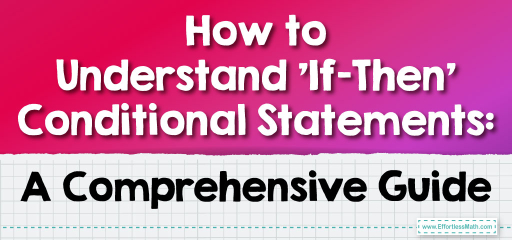How to Understand ‘If-Then’ Conditional Statements: A Comprehensive Guide

Examples
Solution:
Hypothesis \(( p )\): It is raining.
Conclusion \(( q )\): The ground is wet.
Example 2: Determining Truth Value
Statement: “If a shape has four sides, then it is a rectangle.”
Solution:
This statement is false because a shape with four sides could be a square, trapezoid, or other quadrilateral, not necessarily a rectangle.
Example 3: Converse, Inverse, and Contrapositive
Statement: “If a number is even, then it is divisible by \(2\).”
Solution:
Converse: If a number is divisible by \(2\), then it is even.
Inverse: If a number is not even, then it is not divisible by \(2\).
Contrapositive: If a number is not divisible by \(2\), then it is not even.
Practice Questions:
- Write the converse, inverse, and contrapositive for the statement: “If a bird is a penguin, then it cannot fly.”
- Determine the truth value of the statement: “If a shape has three sides, then it is a triangle.”
- For the statement “If an animal is a cat, then it is a mammal,” which of the following is its converse?
a) If an animal is a mammal, then it is a cat.
b) If an animal is not a cat, then it is not a mammal.
c) If an animal is not a mammal, then it is not a cat.
Answers:
- Converse: If a bird cannot fly, then it is a penguin.
Inverse: If a bird is not a penguin, then it can fly.
Contrapositive: If a bird can fly, then it is not a penguin. - The statement is true. A shape with three sides is defined as a triangle.
- a) If an animal is a mammal, then it is a cat.
Related to This Article
More math articles
- How to Decod Decimal Numbers: Dive into Place Values
- Full-Length CLEP College Mathematics Practice Test
- How to Find Asymptotes: Vertical, Horizontal and Oblique
- 8th Grade FSA Math FREE Sample Practice Questions
- 7th Grade MEAP Math Worksheets: FREE & Printable
- Areas Formed by Function Contours
- Best Laptop Tables and Carts for online teaching
- Intelligent Math Puzzle – Challenge 81
- 5th Grade Common Core Math FREE Sample Practice Questions
- How to Find Patterns of Equivalent Fractions?




















What people say about "How to Understand ‘If-Then’ Conditional Statements: A Comprehensive Guide - Effortless Math: We Help Students Learn to LOVE Mathematics"?
No one replied yet.